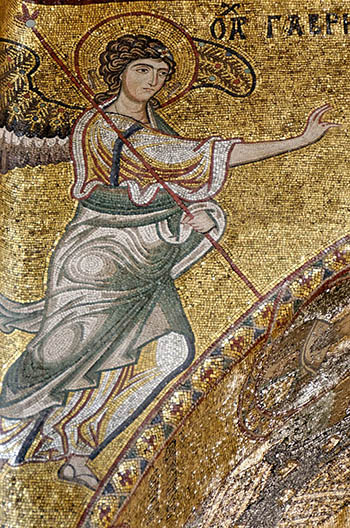
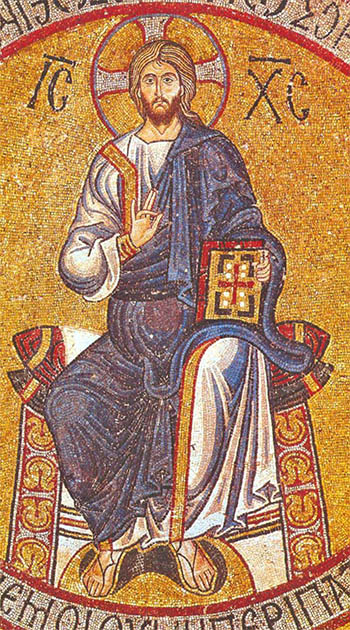
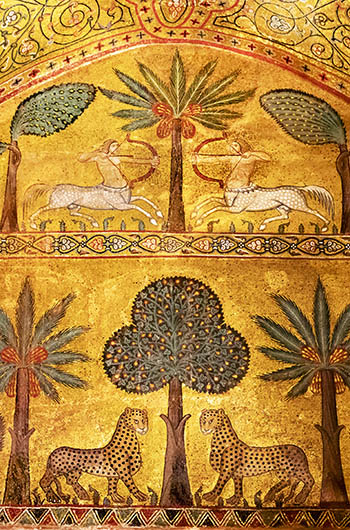
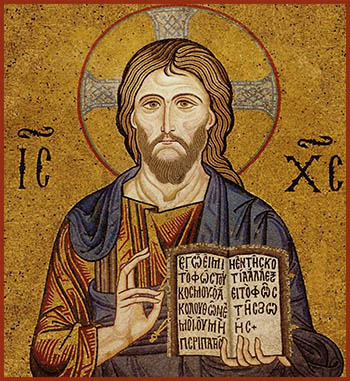
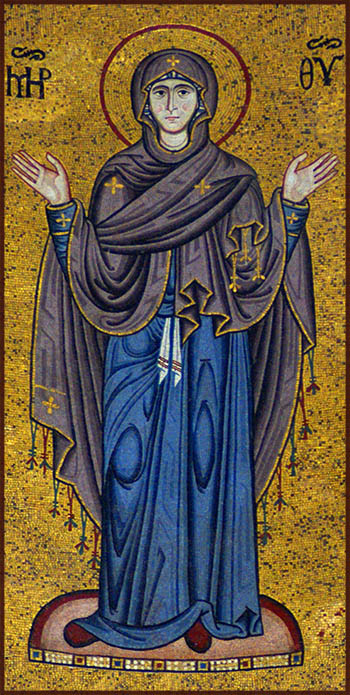
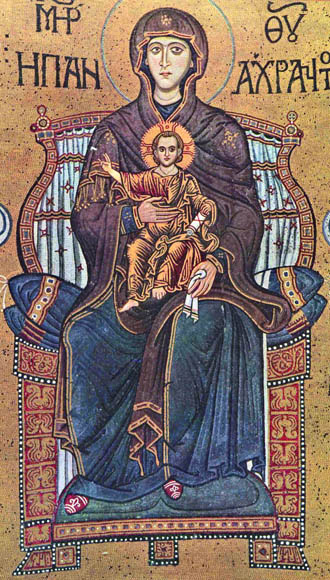

Christ Pantokrator of Cefalu
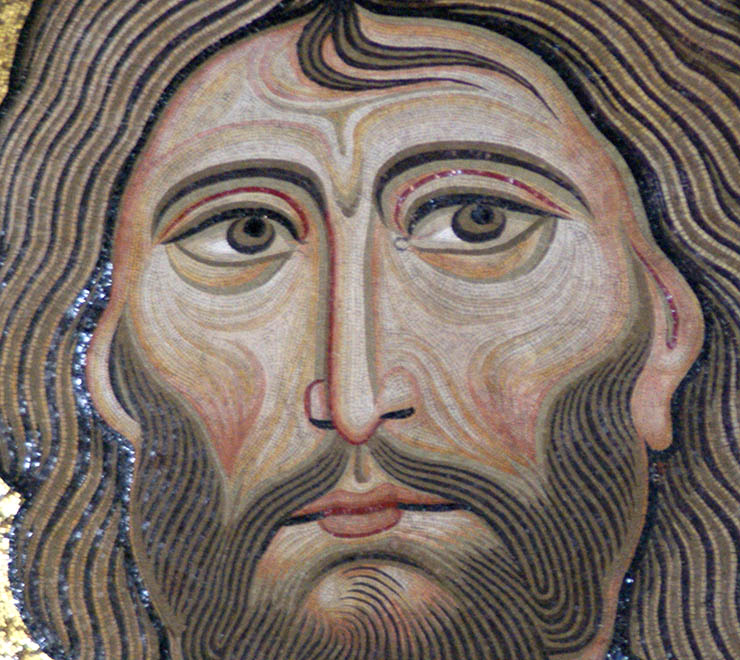 The mosaic glitters because of the extensive use of glass mosaic. See how the red line of the eye lid sparkles. The black outlining the strands of hair is also glass and flashes. The experience of seeing the mosaic is spectacular because of these light effects. This mosaic reminds us of the great portraits of Christ that were created in the churches of Constantinople that are now lost to us. Some have commented on the aristocratic and ascetic beauty of it. I think it is the humanism - the human nature of Christ - that is most apparent here, infused with gentleness.
The mosaic glitters because of the extensive use of glass mosaic. See how the red line of the eye lid sparkles. The black outlining the strands of hair is also glass and flashes. The experience of seeing the mosaic is spectacular because of these light effects. This mosaic reminds us of the great portraits of Christ that were created in the churches of Constantinople that are now lost to us. Some have commented on the aristocratic and ascetic beauty of it. I think it is the humanism - the human nature of Christ - that is most apparent here, infused with gentleness.
His eyes look to the right, away from the viewer in an almost distracted way. His thoughts seem to be full of mercy for humankind.
The number of colors available to the the artists in creating the face and hands makes it appear especially lively and real. The furrows in the face and forehead are soft and subtle.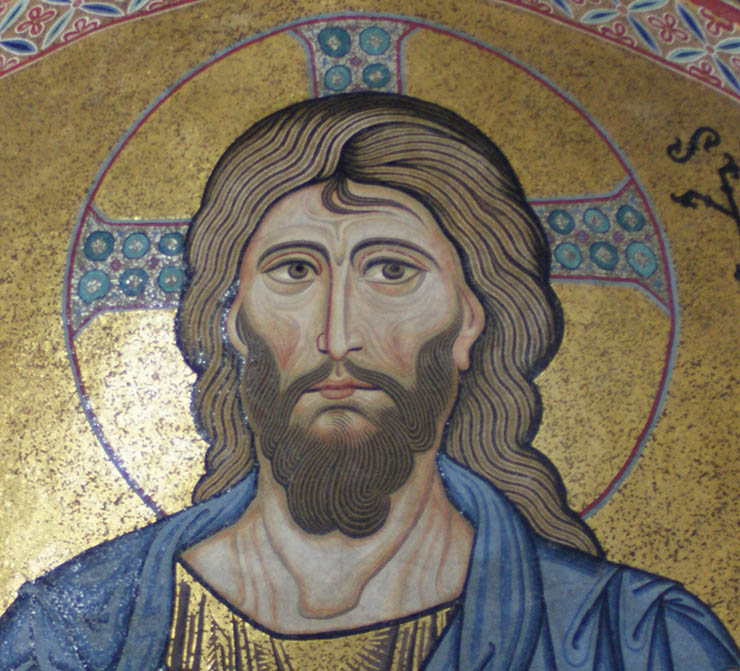 Christ's beard is darker than His hair. Both use the same color of mosaic cubes. The hair is made of a double brown line of mosaic surrounded by two lighter shades. Christ's beard is made of the same base brown cubes with lines drawn in black. The ends of the beard on the chin are finely drawn and the swirls add energy.
Christ's beard is darker than His hair. Both use the same color of mosaic cubes. The hair is made of a double brown line of mosaic surrounded by two lighter shades. Christ's beard is made of the same base brown cubes with lines drawn in black. The ends of the beard on the chin are finely drawn and the swirls add energy.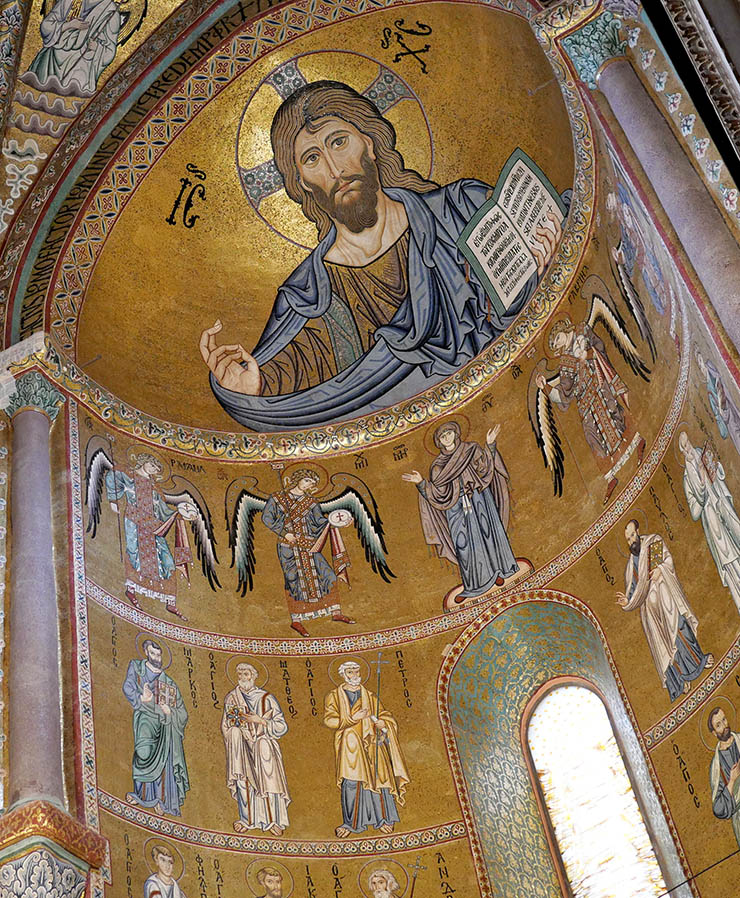
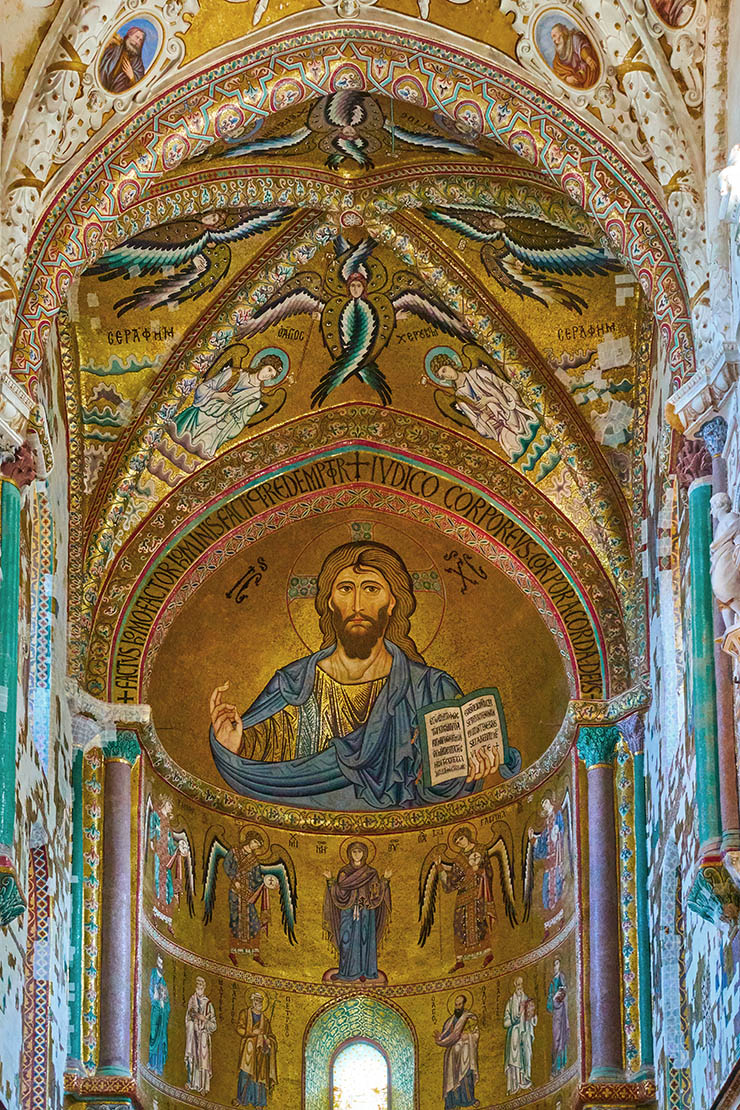 There are four colors of blue glass used in Christ's robe. The more shades of colors the finer modelling in a mosaic. The artist has done an excellent job in modelling the robe by increasing the number of folds which are drawn in black glass cubes. The shades of blue have different glossiness which reflects light in different ways with more sparkle.
There are four colors of blue glass used in Christ's robe. The more shades of colors the finer modelling in a mosaic. The artist has done an excellent job in modelling the robe by increasing the number of folds which are drawn in black glass cubes. The shades of blue have different glossiness which reflects light in different ways with more sparkle.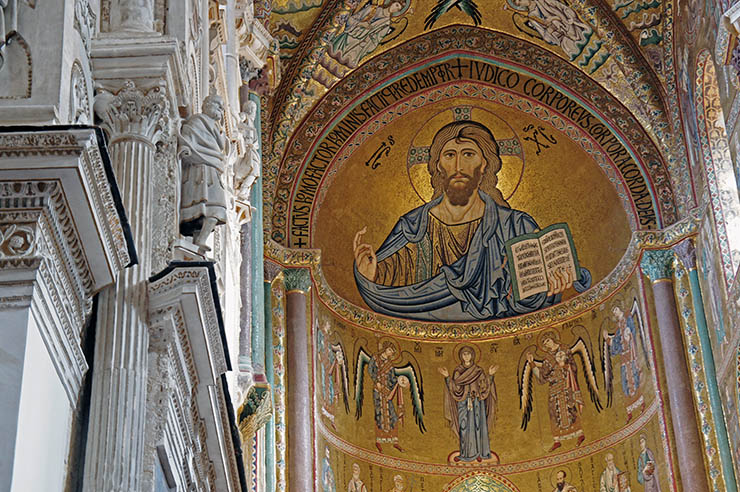 Today we see the mosaic with the benefit of modern lighting. In the 12th century glass lamps were mounted along the apse cornice to light the figure of Christ.
Today we see the mosaic with the benefit of modern lighting. In the 12th century glass lamps were mounted along the apse cornice to light the figure of Christ.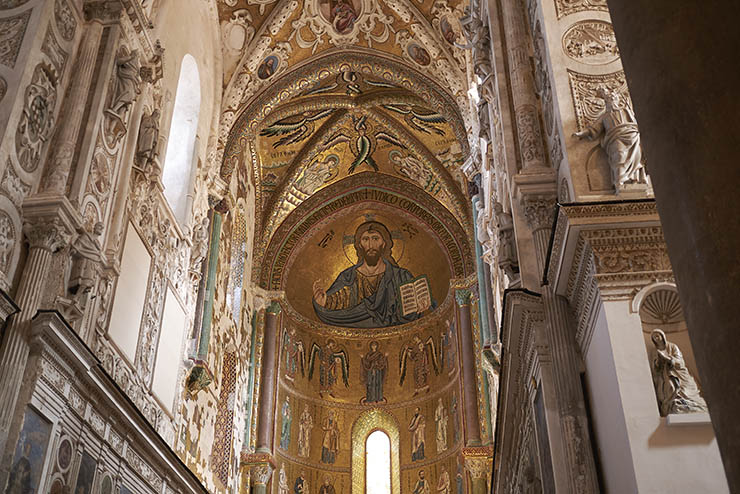
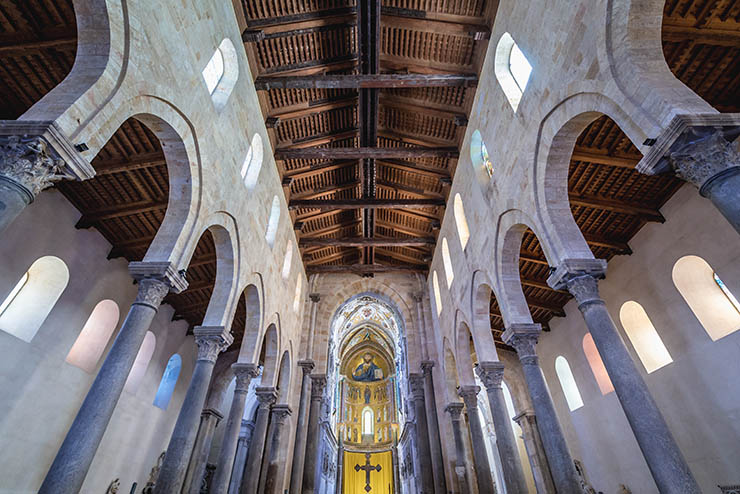 An inscription at the bottom of the apse mosaics gives the date of completion as 1148. The church was founded in 1131 and work on the mosaics began around 1145. They were done by a workshop hired in Constantinople. The then-current Patriarch of Sicily was a former cleric of Hagia Sophia named Neilos Doxopatres, and a member of the Byzantine imperial service. He arrived at Roger’s court before 1142/3. There is an obvious connection between him and these mosaics. This workshop was associated with projects of the Imperial court and they arrived via by merchant ships from Constantinople to Palermo. There was frequent traffic between the two cities. The mosaics were intended as a votive offering to Christ and the Theotokos for the victory of the forces of Roger II in his attack on Manuel I and Byzantium in 1148. Roger had aspirations to assume the throne of Byzantium himself through conquest. The orant figure of the Theotokos with her arms outstretched was intended to echo a similar figure of the Virgin in the Pharos chapel of the area of the Great Palace in Constantinople.
An inscription at the bottom of the apse mosaics gives the date of completion as 1148. The church was founded in 1131 and work on the mosaics began around 1145. They were done by a workshop hired in Constantinople. The then-current Patriarch of Sicily was a former cleric of Hagia Sophia named Neilos Doxopatres, and a member of the Byzantine imperial service. He arrived at Roger’s court before 1142/3. There is an obvious connection between him and these mosaics. This workshop was associated with projects of the Imperial court and they arrived via by merchant ships from Constantinople to Palermo. There was frequent traffic between the two cities. The mosaics were intended as a votive offering to Christ and the Theotokos for the victory of the forces of Roger II in his attack on Manuel I and Byzantium in 1148. Roger had aspirations to assume the throne of Byzantium himself through conquest. The orant figure of the Theotokos with her arms outstretched was intended to echo a similar figure of the Virgin in the Pharos chapel of the area of the Great Palace in Constantinople.
The great Seraphim in the vaults duplicate those in the South Gallery of Hagia Sophia.
The work moved down, from the Christ in the apse and the vaults to the apse figures. The last completed in 1160 or 1170 were the saints in the lowest register.
Although the mosaic glass was likely produced in Constantinople, the Norman kings had conquered part of North Africa so they could control the gold trade from Sudan. Gold was in short supply at this time due to the economy of the 12th century and the gold glass might have been made locally on the island.
Roger had intended the church to be the location of his tomb and had two porphyry sarcophagi brought here in 1154. However, Roger was buried in Palermo. The mosaics of Cefalu are the closest in style to the vanished mosaics of the Pantokrator monastery in Constantinople that had been built by the father of Manuel I, John II Komnenos. It is even possible that some of the same artists worked in both places.

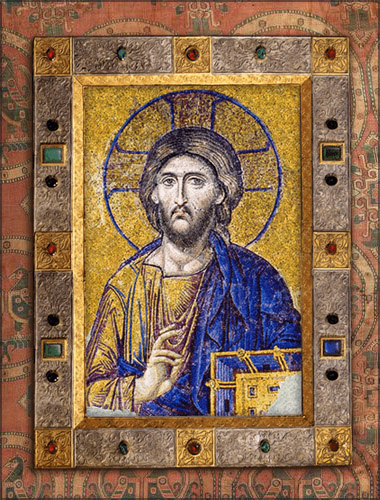


 click here for icons of christ
click here for icons of christ click here for icons of the theotokos
click here for icons of the theotokos click here for icons of angels
click here for icons of angels click here for icons of saints
click here for icons of saints








